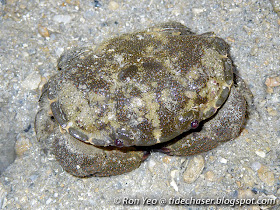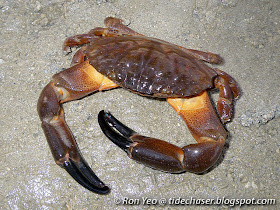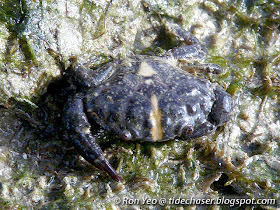Rubble crabs (phylum Arthropoda, subphylum Crustacea, class Malacostraca, order Decapoda, superfamily Xanthoidea, family Xanthidae) are mostly found living among coral rubble, in coral reefs, and rocky shores.

They come in a variety of shapes, and the carapace can be hexagonal to round. Some species may have numerous sharp spines, while others may have blunt lobes or are unarmed. The fingers of the pincers of some species may be spoon-tipped to aid with the scraping of algae from rocks. For most species, the frontal margin between the eyes usually has a notch in the middle.
Like other true crabs, rubble crabs have a broad carapace, and a very short and flattened abdomen which is usually folded underneath the body. They also have five pairs of "legs" (including the clawed arms, or chelipeds), and hence they are placed in the order Decapoda ("deca" means "ten", while "poda" means "feet"). The gills are leaf-like - a distinctive characteristic of decapods from the suborder Pleocyemata. And as with other crustaceans from the class Malacostraca, their body comprises three main parts - a head with five segments, a thorax with eight segments, and an abdomen with six segments. The head is fused to the thorax, forming a cephalothorax. They have a tough exoskeleton strengthened with calcium carbonate, and the carapace covers the gills but not the abdomen.
Rubble crabs reproduce sexually, and have separate sexes. They mate face-to-face, usually with the male on top and the female below. The females can usually be distinguished from the males by having a broader abdomen. This is an adaptation to allow them to carry the eggs under their abdomen until they hatch.
Rubble crabs are sometimes confused with swimming crabs (family Portunidae) due to the hexogonal carapaces of some species, though they lack the paddle-like back legs found in swimming crabs. Some of the species with bigger claws may also be confused with crabs of the superfamily Eriphioidea [such as forceps crabs (family Oziidae), stone crabs (family Menippidae) and red-eyed crabs (family Eriphiidae)], but the latter usually have huge teeth at the base of the fingers of the pincers. Some rubble crabs may also be confused with hairy crabs (family Pilumnidae) due to their hairy appearance, but the hairy crabs usually lack the distinctive notch on the frontal margin of the carapace.
Many species feed on algae, and as a result a number of them are known to be poisonous, due to the toxins in the algae or animals they feed on. Some of the most poisonous crabs in the region are of this family.
Here are some of the rubble crabs that can be seen Singapore.

The Mosaic Crab (Lophozozymus pictor) is the most poisonous crab in Singapore, with several recorded cases of people being killed by its poison after consuming it. It can be recognised by its smooth red carapace marked with whitish mosaic-like patterns. Juvenile crabs have less of the whitish patterns and more red patches. Studies showed that several toxins are found in this species, though the main toxin is palytoxin, a highly toxic chemical from zoanthids. This crab has been observed to feed on both algae and small animals. It is possible that it can accumulate the toxins from the food it has eaten. A research has also shown that some specimens are not poisonous, adding weight to the theory that it gets the toxins from external sources. The toxin cannot be broken down by heat, making it equally dangerous either cooked or uncooked. The maximum carapace width is about 8cm. It is usually found in or near coral reefs.

The Red Egg Crab (Atergatis integerrimus) can be recognised by its red oval carapace. The common name comes from the colour and shape of the carapace. Unlike the previous species, it lacks teeth on the carapace's sides. It has been observed to feed on algae and also small animals. This crab is poisonous, though no death cases have been recorded as yet. The maximum carapace width is about 10cm. It is usually found on reef flats among coral rubble and in coral reefs.

The Brown Egg Crab (Atergatis floridus) has a smooth, brown, oval carapace that is marked with pale flower-like patterns. It has been observed to feed on small animals. It is usually found on reef flats among coral rubble and in coral reefs. The maximum carapace width is about 5cm. This is a very poisonous crab, and several death cases from consuming this species have been recorded.

The Granulated Flatfoot (Platypodia granulosa) is the second most poisonous crab in Singapore. It got its common name from the flattened ridges on its legs. It has an oval carapace, and the entire brownish exoskeleton is covered in tiny granules. The maximum carapace width is about 6cm. It is usually found on reef flats or in coral reefs.

The Hairy Coral Crab (Cymo andreossyi) is usually found living among branching corals (such as Acropora spp. or Pocillopora spp.). This tiny crab is about 1cm wide, and can be easily distinguished from other small crabs living in corals by their hairy appearance. They mostly feed on the mucus produced by the corals, but are known to also feed on detritus (tiny decaying matter).

The Exsculptate Rubble Crab (Euxanthus exsculptus) has numerous variable and irregular depressed lines on its carapace that resemble sculptured work. It is sometimes seen in coral reefs or among coral rubble. The carapace gets to a maximum width of about 6cm.

The Smooth Spooner (Etisus laevimanus) got its name from the smooth carapace and the spoon-like tips of the pincer fingers. The spoon-like tips allow the crab to scrape algae and detritus off the rocks to feed on. The colour and patterns of this species are very variable, from grey to reddish brown, and often with patches of a different colour on the back.

The above photo features a smooth spooner that is all brownish without patches of other colours. This crab grows to about 8cm wide (carapace only), and it sometimes consumed. However, studies suggest that some specimens may be mildly poisonous. It is usually found on coral reefs, areas with coral rubble, and sometimes rocky areas.

The Sawedged Spooner (Etisus utilis) can be easily distinguished from the previous species by the sharp spines on the sides of the carapace, which gives it its common name. This large crab has a maximum carapace width of about 15cm, and is sometimes caught for consumption. It is mostly brown, though some specimens may have pale patterns on the carapace. Studies suggest that this species may be mildly poisonous in some places though. It is usually found on coral reefs. This species has spoon-tipped pincer fingers as well, which allow it to scrape off algae and detritus from rocks.

Rock Crabs (Leptodius spp.) are very commonly found on rocky shores and coral reefs. They are usually found hiding under rocks and coral rubble, and the carapace width seldom exceed 3.5cm. The fingers of their pincers are spoon-tipped as well, allowing them to scrape algae and detritus off rocks to feed on.

The above photo features another Rock Crab (Leptodius sp.) of a different colour

Some Rock Crabs are very tiny, hardly more than 1cm wide.

This tiny female Rock Crab is gravid (with eggs), showing that it is already mature despite the small size. Like other Rock Crabs, the tips of the fingers of its pincers are spoon-like.
References

They come in a variety of shapes, and the carapace can be hexagonal to round. Some species may have numerous sharp spines, while others may have blunt lobes or are unarmed. The fingers of the pincers of some species may be spoon-tipped to aid with the scraping of algae from rocks. For most species, the frontal margin between the eyes usually has a notch in the middle.
Like other true crabs, rubble crabs have a broad carapace, and a very short and flattened abdomen which is usually folded underneath the body. They also have five pairs of "legs" (including the clawed arms, or chelipeds), and hence they are placed in the order Decapoda ("deca" means "ten", while "poda" means "feet"). The gills are leaf-like - a distinctive characteristic of decapods from the suborder Pleocyemata. And as with other crustaceans from the class Malacostraca, their body comprises three main parts - a head with five segments, a thorax with eight segments, and an abdomen with six segments. The head is fused to the thorax, forming a cephalothorax. They have a tough exoskeleton strengthened with calcium carbonate, and the carapace covers the gills but not the abdomen.
Rubble crabs reproduce sexually, and have separate sexes. They mate face-to-face, usually with the male on top and the female below. The females can usually be distinguished from the males by having a broader abdomen. This is an adaptation to allow them to carry the eggs under their abdomen until they hatch.
Rubble crabs are sometimes confused with swimming crabs (family Portunidae) due to the hexogonal carapaces of some species, though they lack the paddle-like back legs found in swimming crabs. Some of the species with bigger claws may also be confused with crabs of the superfamily Eriphioidea [such as forceps crabs (family Oziidae), stone crabs (family Menippidae) and red-eyed crabs (family Eriphiidae)], but the latter usually have huge teeth at the base of the fingers of the pincers. Some rubble crabs may also be confused with hairy crabs (family Pilumnidae) due to their hairy appearance, but the hairy crabs usually lack the distinctive notch on the frontal margin of the carapace.
Many species feed on algae, and as a result a number of them are known to be poisonous, due to the toxins in the algae or animals they feed on. Some of the most poisonous crabs in the region are of this family.
Here are some of the rubble crabs that can be seen Singapore.

The Mosaic Crab (Lophozozymus pictor) is the most poisonous crab in Singapore, with several recorded cases of people being killed by its poison after consuming it. It can be recognised by its smooth red carapace marked with whitish mosaic-like patterns. Juvenile crabs have less of the whitish patterns and more red patches. Studies showed that several toxins are found in this species, though the main toxin is palytoxin, a highly toxic chemical from zoanthids. This crab has been observed to feed on both algae and small animals. It is possible that it can accumulate the toxins from the food it has eaten. A research has also shown that some specimens are not poisonous, adding weight to the theory that it gets the toxins from external sources. The toxin cannot be broken down by heat, making it equally dangerous either cooked or uncooked. The maximum carapace width is about 8cm. It is usually found in or near coral reefs.

The Red Egg Crab (Atergatis integerrimus) can be recognised by its red oval carapace. The common name comes from the colour and shape of the carapace. Unlike the previous species, it lacks teeth on the carapace's sides. It has been observed to feed on algae and also small animals. This crab is poisonous, though no death cases have been recorded as yet. The maximum carapace width is about 10cm. It is usually found on reef flats among coral rubble and in coral reefs.

The Brown Egg Crab (Atergatis floridus) has a smooth, brown, oval carapace that is marked with pale flower-like patterns. It has been observed to feed on small animals. It is usually found on reef flats among coral rubble and in coral reefs. The maximum carapace width is about 5cm. This is a very poisonous crab, and several death cases from consuming this species have been recorded.

The Granulated Flatfoot (Platypodia granulosa) is the second most poisonous crab in Singapore. It got its common name from the flattened ridges on its legs. It has an oval carapace, and the entire brownish exoskeleton is covered in tiny granules. The maximum carapace width is about 6cm. It is usually found on reef flats or in coral reefs.

The Hairy Coral Crab (Cymo andreossyi) is usually found living among branching corals (such as Acropora spp. or Pocillopora spp.). This tiny crab is about 1cm wide, and can be easily distinguished from other small crabs living in corals by their hairy appearance. They mostly feed on the mucus produced by the corals, but are known to also feed on detritus (tiny decaying matter).

The Exsculptate Rubble Crab (Euxanthus exsculptus) has numerous variable and irregular depressed lines on its carapace that resemble sculptured work. It is sometimes seen in coral reefs or among coral rubble. The carapace gets to a maximum width of about 6cm.

The Smooth Spooner (Etisus laevimanus) got its name from the smooth carapace and the spoon-like tips of the pincer fingers. The spoon-like tips allow the crab to scrape algae and detritus off the rocks to feed on. The colour and patterns of this species are very variable, from grey to reddish brown, and often with patches of a different colour on the back.

The above photo features a smooth spooner that is all brownish without patches of other colours. This crab grows to about 8cm wide (carapace only), and it sometimes consumed. However, studies suggest that some specimens may be mildly poisonous. It is usually found on coral reefs, areas with coral rubble, and sometimes rocky areas.

The Sawedged Spooner (Etisus utilis) can be easily distinguished from the previous species by the sharp spines on the sides of the carapace, which gives it its common name. This large crab has a maximum carapace width of about 15cm, and is sometimes caught for consumption. It is mostly brown, though some specimens may have pale patterns on the carapace. Studies suggest that this species may be mildly poisonous in some places though. It is usually found on coral reefs. This species has spoon-tipped pincer fingers as well, which allow it to scrape off algae and detritus from rocks.

Rock Crabs (Leptodius spp.) are very commonly found on rocky shores and coral reefs. They are usually found hiding under rocks and coral rubble, and the carapace width seldom exceed 3.5cm. The fingers of their pincers are spoon-tipped as well, allowing them to scrape algae and detritus off rocks to feed on.

The above photo features another Rock Crab (Leptodius sp.) of a different colour

Some Rock Crabs are very tiny, hardly more than 1cm wide.

This tiny female Rock Crab is gravid (with eggs), showing that it is already mature despite the small size. Like other Rock Crabs, the tips of the fingers of its pincers are spoon-like.
References
- Carpenter, K. E. & V. H. Niem (eds), 1998-2001. FAO species identification guide for fishery purposes. The living marine resources of the Western Central Pacific. Volumes 1 to 6. FAO, Rome. pp. 1-4218.
- De Grave, S., N. D. Pentcheff , S. T. Ahyong, T.-Y. Chan, K. A. Crandall, P. C. Dworschak, D. L. Felder, R. M. Feldmann, C. H. J. M. Fransen, L. Y. D. Goulding, R. Lemaitre, M. E. Y. Low, J. W. Martin, P. K. L. Ng, C. E. Schweitzer, S. H. Tan, D. Tshudy & R. Wetzer. 2009. A classification of living and fossil genera of decapod crustaceans. The Raffles Bulletin of Zoology, supplement 21, pp. 1-109.
- Debelius, H. 1999. Crustacea - Guide of the world. IKAN, Frankfurt. 321pp.
- ETI BioInformatics. 2012. Marine species identification portal. Retrieved Jul 8, 2013, from http://species-identification.org.
- Lau, C. O., C. H. Tan, H. E. Khoo, R. Yuen, R. J. Lewis, G. P. Corpuz & G. S. Bignami. 1995. Lophozozymus pictor toxin: A fluorescent structural isomer of palytoxin. Toxicon 33(10): 1373-1377
- Ng, P. K. L., S. S. L. Lim, L. K. Wang & L. W. H. Tan. 2007. Private lives: An exposé of Singapore's shores. The Raffles Museum of Biodiversity Research, Department of Biological Sciences, National University of Singapore. 212 pp.
- Ng, P. K .L., R. T. Corlett & H.T.W. Tan (eds.). 2011. Singapore biodiversity: An encyclopedia of the natural environment and sustainable development. Singapore: Editions Didier Millet. 552 pp.
- World Register of Marine Species. 2012. Retrieved Jun 10, 2013, from http://www.marinespecies.org.

No comments:
Post a Comment